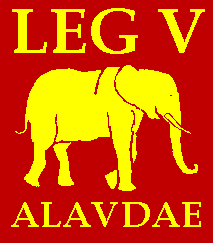
Ulpius Cornelius Laelianus was a usurper against Postumus, the emperor of the Gallic Empire. His revolt lasted from approximately late February to early June 269.

Legio IV Macedonica, was a legion of the Imperial Roman army founded in 48 BC by Gaius Julius Caesar with Italian legionaries. The legion was disbanded in AD 70 by Emperor Vespasian. The legion symbols were a bull and a capricorn.

Legio V Alaudae, sometimes also known as Gallica, was a legion of the Imperial Roman army founded in 52 BC by the general Gaius Julius Caesar. It was levied in Transalpine Gaul to fight the armies of Vercingetorix, and was the first Roman legion to comprise non-citizens. Historians disagree whether the legion was destroyed during the Batavian rebellion in AD 70, or during the First Battle of Tapae.
Legio XV Primigenia was a legion of the Imperial Roman army. Primigena ("firstborn") was one of the nicknames accorded to the Roman goddess Fortuna. Primigenia is an adjective, meaning "of Primigena".

Legio XXII Primigenia was a legion of the Imperial Roman army dedicated to the goddess Fortuna Primigenia. Founded in AD 39 by the emperor Caligula for use in his campaigns in Germania, the XXII Primigenia spent much of their time in Mogontiacum up to the end of the 3rd century. The legion's symbols were a Capricorn and the demigod Hercules.

The flannel moths or crinkled flannel moths are a family of insects. They occur in North America and the New World tropics. The larvae are called puss caterpillars, and with their long hairs, resemble cotton balls. They have venomous spines that can cause a painful sting and inflammation lasting for several days. In some cases, the sting may cause headache, nausea, and shock-like symptoms. Perhaps the most notorious for stinging is the caterpillar of Megalopyge opercularis.

Grus is a genus of large birds in the crane family.

The grey-hooded sunbird is a species of bird in the family Nectariniidae. It is endemic to the Philippines.
Hysterocladia is a genus of moths in the family Megalopygidae.

Naticopsis is an extinct genus of small sea snails belonging to the family Neritopsidae.
Hysterocladia servilis is a moth of the family Megalopygidae. It was described by Walter Hopp in 1927. It is found in Peru.
Hysterocladia tolimensis is a moth of the family Megalopygidae. It was described by Walter Hopp in 1927. It is found in Colombia.
Hysterocladia werneri is a moth of the family Megalopygidae. It was described by Walter Hopp in 1927. It is found in Colombia.
Hysterocladia ferecostata is a moth of the family Megalopygidae. It was described by Walter Hopp in 1927. It is found in Peru.
Hysterocladia corallocera is a moth of the Megalopygidae family. It was described by Felder in 1874. It is found in Venezuela and French Guiana.
Hysterocladia eriphua is a moth of the Megalopygidae family. It was described by Paul Dognin in 1914. It is found in Panama.
Hysterocladia lena is a moth of the Megalopygidae family. It was described by Schaus in 1912. It is found in Costa Rica.
Hysterocladia roseicollis is a moth of the Megalopygidae family. It was described by Paul Dognin in 1914. It is found in Peru and French Guiana.
Hysterocladia unimana is a moth of the family Megalopygidae. It was described by Walter Hopp in 1943. It is found in Brazil.

Leucetta is a genus of sponges in the family Leucettidae, which was first described in 1872 by Ernst Haeckel. The type species is Leucetta primigenia Haeckel, 1872 by subsequent designation.








